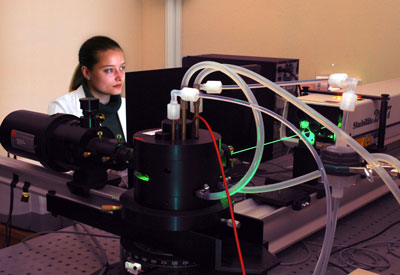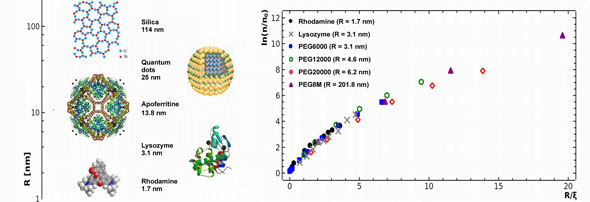| Posted: June 25, 2010 |
Viscosity at the nanoscale: 50-year-old intriguing puzzle solved |
|
(Nanowerk News) At a snail's pace - this is how proteins should move inside living cells where viscosity of environment exceeds the viscosity of water even by million times. However, proteins move not much slower than in water! While looking for a solution to this puzzle, scientists from the Institute of Physical Chemistry of the PolishAcademy of Sciences discovered a new principle of physics.
|
|
Why do biological processes occur in a nucleus? It is so overcrowded by macromolecules, so viscous, that proteins should move extremely slowly there. Under such conditions the pace at which proteins aggregate into complexes and at which molecules join DNA chains cannot be effective. "But we know that proteins in living cells move several hundred thousand faster than they should. We managed to discover why this is so," says Prof. Robert Holyst from the Institute of Physical Chemistry of the PAS (IPC PAS).
|
 |
| Analysis of motion of nanoobjects using dynamic light scattering.
|
|
Human senses do not allow us to identify changes in viscosity well. The viscosity of rape oil seems to be relatively similar to the viscosity of water, though the latter is 400 times lower. Consequently, we often confuse viscosity and density. For example, shampoo comprises 95% of water and has similar density but due to its high viscosity it spills over a hand slowly. Honey is also viscous, not dense.
|
|
Viscosity appeared as a parameter in physics in the Navier-Stokes equations discovered in the 19th century. They describe river flow and air flow around plane wings correctly. According to this description, viscosity is not dependent on scale and should produce the same results in the case of a flying airplane and a protein particle moving inside a nucleus. However, measurements show something different. As early as in the 1950s, experiments, conducted in ultracentrifuges and concerning sedimentation of small particles at high load factors, revealed a surprising fact. It turned out that objects several billion times smaller can feel viscosity several thousand and even hundred thousand lower than a macroscopic object. A reason of such a dramatic change in viscosity could not be found for a long time.
|
|
Although viscosity was already examined by Newton, it has remained a mysterious property of nature to date. We understand its origin in gases: when two layers of gas move against each other, a molecule may jump from one layer to the other, there are collisions and the motion slows down. However, when gas becomes dense and turns into liquid, there are interactions between molecules and it is hard to indicate phenomena that are directly responsible for the origin of viscosity. As a result, scientists are still examining viscosity in the simplest real fluids made of atoms of argon and other noble gases.
|
|
A group of researchers from the Institute of Physical Chemistry of the PAS, under the direction of Prof. Holyst, has shown recently that in each hydrodynamic system there is a fundamental length scale at which there is a transition from macroviscosity to nanoviscosity. The size of this scale depends on the size of objects present in the fluid: in the case of polymers it will be the size of a random coil, and in the suspension of viruses – the length of a virus rod. "If the size of a polymer coil is 10 nanometres, each object bigger than the coil, immersed in the polymer solution will feel macroscopic viscosity, and every smaller one – nanoviscosity," explains Prof. Holyst. It is particularly interesting that changes in viscosity are exponential in length, which means that near the fundamental length scale they are very sharp. The decrease of the size of a floating object may result in the change of viscosity by as much as 5-6 orders of magnitude. The discovery of the researchers from the IPC PAS means that the existing hydrodynamic equations in which the parameter of viscosity is constant will have to be reformulated in future.
|
 |
| Left: Nanoparticles used to study nanoviscosity (sizes in nanometers). Right: Scaling plot of nano and macroviscosity showing that they are described by the same functional form. Vertical axis logarithm of viscosity divided my water viscosity and horizontal axis ratio of probe size to the correlation length in polymer solution (blob size). (Source: IPC PAS)
|
|
The measurements were conducted as part of the research project with the use of the newest methods and equipment such as a confocal microscope with Fluorescence Correlation Spectroscopy. This new research technique allows the behaviour of individual protein molecules in liquids with capacity of cubical micrometers to be watched in the laser focus. The experiments were carried out for six years; for two years they were sponsored by the British concern Unilever, interested in the application of the results in the creation of new shampoos and conditioners.
|
|
From the scientific point of view, research on nanoviscosity is of fundamental importance since nanoviscosity influences the rate of diffusion and limits the speed of biochemical reactions inside living cells. "It is not incidental that proteins in a cell, usually the small ones, create complexes only in the vicinity of a place where the biochemical reaction is to proceed. This is necessary since a large complex would move million times slower than each protein separately," explains Prof. Holyst. Scientists hope that their discovery will be used by industry, where viscosity plays a key role in many biotechnological reactions. Producers of shampoos and cosmetics will certainly benefit from the results. The new principle of physics will also be important for the construction of nanodevices. "Science still hardly understands phenomena occurring at such a small scale. If we want to build nanomachines, we should learn as much as possible about phenomena typical for the world in which they are to work," concludes Prof. Holyst.
|
|
The Institute of Physical Chemistry of the Polish Academy of Sciences (http://www.ichf.edu.pl/) was established in 1955 as one of the first chemical institutes of the PAS. The Institute's scientific profile is strongly related to the newest global trends in the development of physical chemistry and chemical physics. Scientific research is conducted in nine scientific departments. CHEMIPAN R&D Laboratories operating as part of the Institute implement, produce and commercialise specialist chemical compounds to be used, in particular, in agriculture and pharmacy. The Institute publishes approximately 300 original research papers annually.
|


